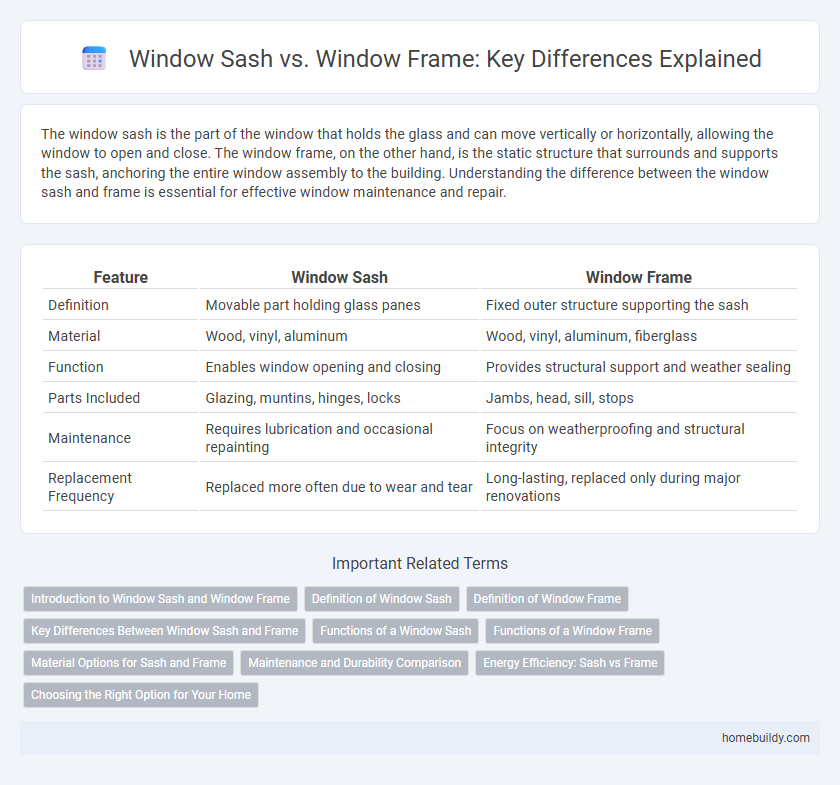The window sash is the part of the window that holds the glass and can move vertically or horizontally, allowing the window to open and close. The window frame, on the other hand, is the static structure that surrounds and supports the sash, anchoring the entire window assembly to the building. Understanding the difference between the window sash and frame is essential for effective window maintenance and repair.
Table of Comparison
| Feature | Window Sash | Window Frame |
|---|---|---|
| Definition | Movable part holding glass panes | Fixed outer structure supporting the sash |
| Material | Wood, vinyl, aluminum | Wood, vinyl, aluminum, fiberglass |
| Function | Enables window opening and closing | Provides structural support and weather sealing |
| Parts Included | Glazing, muntins, hinges, locks | Jambs, head, sill, stops |
| Maintenance | Requires lubrication and occasional repainting | Focus on weatherproofing and structural integrity |
| Replacement Frequency | Replaced more often due to wear and tear | Long-lasting, replaced only during major renovations |
Introduction to Window Sash and Window Frame
A window sash refers to the movable part of the window that holds the glass panes, allowing it to open or close for ventilation. The window frame is the stationary outer structure that supports and secures the sash within the wall opening. Understanding the distinction between the sash and frame is essential for selecting, installing, and maintaining efficient and durable windows.
Definition of Window Sash
A window sash refers to the movable framework that holds the glass panes within a window, allowing it to open and close. Unlike the fixed window frame, which provides structural support and is attached to the wall, the sash contains the operable parts of the window. Understanding the distinction between the window sash and window frame is essential for maintenance, repair, and replacement tasks.
Definition of Window Frame
A window frame is the fixed outer structure that holds the entire window assembly, including the window sash, in place within a wall opening. It provides structural support and weatherproofing, ensuring the window remains secure and insulated. Unlike the window sash, which is the movable or operable part holding the glass, the frame remains stationary and serves as the foundational component of the window system.
Key Differences Between Window Sash and Frame
A window sash is the movable part of the window that holds the glass panes and can open or close, while the window frame is the stationary structure that supports the sash and anchors the window to the wall. The sash operates within the frame, allowing ventilation and access, whereas the frame provides structural stability and weatherproofing. Understanding these distinctions is crucial for selecting, repairing, or upgrading window components to ensure proper functionality and energy efficiency.
Functions of a Window Sash
A window sash functions as the movable part of a window that holds the glass panes securely, allowing for ventilation and easy cleaning. It supports the glass and the glazing, enabling the window to open and close smoothly within the fixed window frame. Unlike the window frame, which provides structural support and houses the sash, the sash is essential for operational functionality and insulation control.
Functions of a Window Frame
A window frame provides structural support, securing the entire window assembly within the wall opening while ensuring weather resistance and insulation. Unlike the window sash, which holds the glass and opens or closes, the frame maintains stability and alignment, preventing drafts and water infiltration. Its robust materials enhance durability and contribute to the overall energy efficiency of the building.
Material Options for Sash and Frame
Window sashes and frames are crafted from a variety of materials, including wood, vinyl, aluminum, fiberglass, and composite blends, each offering distinct durability and insulation properties. Wood sashes provide natural aesthetics and superior insulation but require regular maintenance, while vinyl and aluminum frames deliver cost-effective, low-maintenance alternatives with good weather resistance. Fiberglass and composite materials combine the strength and thermal efficiency of wood with the resilience and minimal upkeep of synthetic options, making them ideal for long-lasting window components.
Maintenance and Durability Comparison
Window sash requires more frequent maintenance due to its moving parts and exposure to weather elements, often needing lubrication, repainting, or sealing to maintain smooth operation. In contrast, the window frame is generally more durable and structurally stable, providing long-term support with less frequent upkeep focused on cleaning and occasional inspections for damage or rot. Choosing materials like vinyl or fiberglass for both sash and frame can significantly enhance overall durability and reduce maintenance efforts.
Energy Efficiency: Sash vs Frame
Window sashes and frames both impact energy efficiency, but their roles differ significantly. The window sash holds the glass panes and often includes weatherstripping to minimize air leakage, directly influencing insulation performance. Meanwhile, the window frame provides structural support and can affect thermal transfer depending on the material used, with options like vinyl or fiberglass offering superior energy-saving properties compared to traditional wood or aluminum.
Choosing the Right Option for Your Home
When selecting between a window sash and a window frame, consider that the sash refers to the movable part holding the glass, while the frame is the stationary structure supporting the sash. Choosing the right option depends on factors such as energy efficiency, ease of maintenance, and architectural style compatibility. Opt for sash windows in historic or traditional homes for aesthetic appeal, and prioritize durable, insulated frames in modern builds to enhance thermal performance.
window sash vs window frame Infographic

 homebuildy.com
homebuildy.com